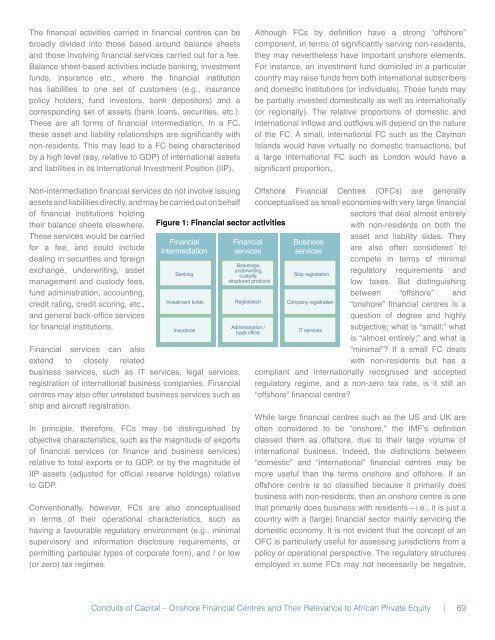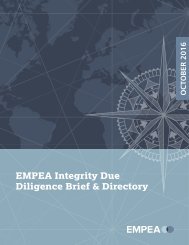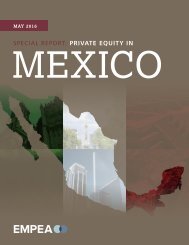Create successful ePaper yourself
Turn your PDF publications into a flip-book with our unique Google optimized e-Paper software.
The financial activities carried in financial centres can be<br />
broadly divided into those based around balance sheets<br />
and those involving financial services carried out for a fee.<br />
Balance sheet-based activities include banking, investment<br />
funds, insurance etc., where the financial institution<br />
has liabilities to one set <strong>of</strong> customers (e.g., insurance<br />
policy holders, fund investors, bank depositors) and a<br />
corresponding set <strong>of</strong> assets (bank loans, securities, etc.).<br />
These are all forms <strong>of</strong> financial intermediation. In a FC,<br />
these asset and liability relationships are significantly with<br />
non-residents. This may lead to a FC being characterised<br />
by a high level (say, relative to GDP) <strong>of</strong> international assets<br />
and liabilities in its International Investment Position (IIP).<br />
Non-intermediation financial services do not involve issuing<br />
assets and liabilities directly, and may be carried out on behalf<br />
<strong>of</strong> financial institutions holding<br />
their balance sheets elsewhere.<br />
These services would be carried<br />
for a fee, and could include<br />
dealing in securities and foreign<br />
exchange, underwriting, asset<br />
management and custody fees,<br />
fund administration, accounting,<br />
credit rating, credit scoring, etc.,<br />
and general back-<strong>of</strong>fice services<br />
for financial institutions.<br />
Financial services can also<br />
extend to closely related<br />
business services, such as IT services, legal services,<br />
registration <strong>of</strong> international business companies. Financial<br />
centres may also <strong>of</strong>fer unrelated business services such as<br />
ship and aircraft registration.<br />
In principle, therefore, FCs may be distinguished by<br />
objective characteristics, such as the magnitude <strong>of</strong> exports<br />
<strong>of</strong> financial services (or finance and business services)<br />
relative to total exports or to GDP, or by the magnitude <strong>of</strong><br />
IIP assets (adjusted for <strong>of</strong>ficial reserve holdings) relative<br />
to GDP.<br />
Conventionally, however, FCs are also conceptualised<br />
in terms <strong>of</strong> their operational characteristics, such as<br />
having a favourable regulatory environment (e.g., minimal<br />
supervisory and information disclosure requirements, or<br />
permitting particular types <strong>of</strong> corporate form), and / or low<br />
(or zero) tax regimes.<br />
Although FCs by definition have a strong “<strong>of</strong>fshore”<br />
component, in terms <strong>of</strong> significantly serving non-residents,<br />
they may nevertheless have important onshore elements.<br />
For instance, an investment fund domiciled in a particular<br />
country may raise funds from both international subscribers<br />
and domestic institutions (or individuals). Those funds may<br />
be partially invested domestically as well as internationally<br />
(or regionally). The relative proportions <strong>of</strong> domestic and<br />
international inflows and outflows will depend on the nature<br />
<strong>of</strong> the FC. A small, international FC such as the Cayman<br />
Islands would have virtually no domestic transactions, but<br />
a large international FC such as London would have a<br />
significant proportion.<br />
Offshore Financial Centres (OFCs) are generally<br />
conceptualised as small economies with very large financial<br />
sectors that deal almost entirely<br />
with non-residents on both the<br />
asset and liability sides. They<br />
are also <strong>of</strong>ten considered to<br />
compete in terms <strong>of</strong> minimal<br />
regulatory requirements and<br />
low taxes. But distinguishing<br />
between “<strong>of</strong>fshore” and<br />
“onshore” financial centres is a<br />
question <strong>of</strong> degree and highly<br />
subjective; what is “small;” what<br />
is “almost entirely;” and what is<br />
“minimal”? If a small FC deals<br />
with non-residents but has a<br />
compliant and internationally recognised and accepted<br />
regulatory regime, and a non-zero tax rate, is it still an<br />
“<strong>of</strong>fshore” financial centre?<br />
While large financial centres such as the US and UK are<br />
<strong>of</strong>ten considered to be “onshore,” the IMF’s definition<br />
classed them as <strong>of</strong>fshore, due to their large volume <strong>of</strong><br />
international business. Indeed, the distinctions between<br />
“domestic” and “international” financial centres may be<br />
more useful than the terms onshore and <strong>of</strong>fshore. If an<br />
<strong>of</strong>fshore centre is so classified because it primarily does<br />
business with non-residents, then an onshore centre is one<br />
that primarily does business with residents—i.e., it is just a<br />
country with a (large) financial sector mainly servicing the<br />
domestic economy. It is not evident that the concept <strong>of</strong> an<br />
OFC is particularly useful for assessing jurisdictions from a<br />
policy or operational perspective. The regulatory structures<br />
employed in some FCs may not necessarily be negative,<br />
<strong>Conduits</strong> <strong>of</strong> <strong>Capital</strong> – Onshore Financial Centres and Their Relevance to African Private Equity<br />
| 69





